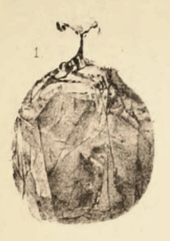1878_in_paleontology
1878 in paleontology
Overview of the events of 1878 in paleontology
Paleontology or palaeontology is the study of prehistoric life forms on Earth through the examination of plant and animal fossils.[1] This includes the study of body fossils, tracks (ichnites), burrows, cast-off parts, fossilised feces (coprolites), palynomorphs and chemical residues. Because humans have encountered fossils for millennia, paleontology has a long history both before and after becoming formalized as a science. This article records significant discoveries and events related to paleontology that occurred or were published in the year 1878.
| |||
|---|---|---|---|
|
Newly named arachnids
| Name | Novelty | Status | Authors | Age | Unit | Location | Notes | Images |
|---|---|---|---|---|---|---|---|---|
|
Aranea columbiae[2] |
Sp nov |
jr synonym |
Quesnel |
An orb-web spider egg sack ichnogenus. |
 (1890 illustration | |||
Newly named insects
| Name | Novelty | Status | Authors | Age | Unit | Location | Notes | Images |
|---|---|---|---|---|---|---|---|---|
|
Bothromicromus[2] |
Gen et Sp nov |
valid |
Quesnel |
A possibly megalomine[4] hemerobiid lacewing. |
 (1890 illustration) | |||
|
Euschistus antiquus[2] |
Sp nov |
jr synonym |
Quesnel |
A shield bug |
 (1890 illustration) | |||
|
Gen et sp nov |
valid |
A holcorpid scorpionfly |
 | |||||
|
Lachnus quesneli[2] |
Sp nov |
jr synonym |
Quesnel |
An aphidoid of uncertain placement |
 (1890 illustration) | |||
|
Sciara deperdita[2] |
Sp nov |
valid |
Quesnel |
A sciarine dark-winged fungus gnat. |
 (1890 illustration) | |||
O. W. Lucas recovers more material which would be referred to Laelaps trihedrodon from Morrison Formation strata near Garden Park, Colorado.[7]
Newly named pseudosuchians
| Name | Novelty | Status | Authors | Age | Unit | Location | Notes | Images |
|---|---|---|---|---|---|---|---|---|
|
Late Jurassic (Kimmeridgian to Tithonian) |
Possible synonym of Amphicotylus.[8] |
|||||||
Newly named dinosaurs
| Name | Novelty | Status | Authors | Age | Unit | Location | Notes | Images |
|---|---|---|---|---|---|---|---|---|
|
Sp nov |
Late Jurassic (Tithonian) |
Unknown |
Moved to Maraapunisaurus fragillimus (2018).[9] |
| ||||
|
Gen nov |
jr synonym |
Late Jurassic (Kimmeridgian to Tithonian) |
Junior synonym of Camptosaurus. |
| ||||
|
Gen nov |
Late Jurassic (Kimmeridgian to Tithonian) |
Synonym of Allosaurus fragilis. |
| |||||
|
Gen et sp nov |
Valid |
Late Jurassic (Kimmeridgian to Tithonian) |
A diplodocine diplodocid. |
| ||||
|
Gen et sp nov |
Late Jurassic (Kimmeridgian to Tithonian) |
An allosaurid theropod. |
||||||
|
Gen et sp nov |
Late Jurassic (Kimmeridgian to Tithonian) |
possibly a synonym of Stegosaurus. | ||||||
|
Gen et sp nov |
Late Jurassic (Kimmeridgian to Tithonian) |
A dubious Neornithischine of uncertain placement. |
| |||||
|
Gen et sp nov |
Late Jurassic (Kimmeridgian to Tithonian) |
Junior synonym of Camarasaurus. |
| |||||
Newly named plesiosaurs
| Name | Novelty | Status | Authors | Age | Unit | Location | Notes | Images |
|---|---|---|---|---|---|---|---|---|
|
Gen et sp nov |
Valid |
Gaudry |
Unknown |
A possible pliosauroid |
||||
Non-mammalian
- Gini-Newman, Garfield; Graham, Elizabeth (2001). Echoes from the past: world history to the 16th century. Toronto: McGraw-Hill Ryerson Ltd. ISBN 9780070887398. OCLC 46769716.
- Scudder, S. H (1878). "Additions to the Insect-fauna of the Tertiary beds at Quesnel, British Columbia". Geological Survey of Canada, Report of Progress for. 1876–1877: 457–464.
- Dunlop, J.A.; Braddy, S.J. (2011). "Cteniza bavincourti and the nomenclature of arachnid-related trace fossils". The Journal of Arachnology. 39: 250–257.
- Makarkin, V.; Wedmann, S.; Weiterschan, T. (2016). "A new genus of Hemerobiidae (Neuroptera) from Baltic amber, with a critical review of the Cenozoic Megalomus-like taxa and remarks on the wing venation variability of the family". Zootaxa. 4179 (3): 345–370. doi:10.11646/zootaxa.4179.3.2.
- Scudder, S. H. (1890). "The Tertiary insects of North America". United States Geological Survey of the Territories, Washington: 615.
- Archibald, SB (2010). "Revision of the scorpionfly family Holcorpidae (Mecoptera), with description of a new species from Early Eocene McAbee, British Columbia, Canada" (PDF). Annales de la Société Entomologique de France. 46 (1–2): 173–182. doi:10.1080/00379271.2010.10697654. Archived from the original (PDF) on 2014-02-22. Retrieved 2015-06-01.
- "Introduction," Chure (2001) page 11.
- Osborn, H.F., and Mook, C. C. (1921). "Camarasaurus, Amphicoelias and other sauropods of Cope." Memoirs of the American Museum of Natural History NS, 3(3): 249–387.
- Chure, Daniel J. (2001). "On the type and referred material of Laelaps trihedrodon Cope 1877 (Dinosauria: Theropoda)". In Tanke, Darren; Carpenter, Kenneth (eds.). Mesozoic Vertebrate Life. Bloomington and Indianapolis: Indiana University Press. pp. 10–18. ISBN 0-253-33907-3.